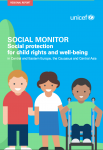Social protection provides the most benefits to children who are falling the furthest behind, a UN Children's Fund (UNICEF) report finds.
The report identifies key challenges that countries in Central and Eastern Europe, the Caucasus and Central Asia face in investing in and meeting children's social protection needs, and proposes recommendations for tackling them.
 20 April 2016: Social protection provides the most benefits to children who are falling the furthest behind, a UN Children’s Fund (UNICEF) report finds. The report identifies key challenges that countries in Central and Eastern Europe, the Caucasus and Central Asia face in investing in and meeting children’s social protection needs, and proposes recommendations for tackling them.
20 April 2016: Social protection provides the most benefits to children who are falling the furthest behind, a UN Children’s Fund (UNICEF) report finds. The report identifies key challenges that countries in Central and Eastern Europe, the Caucasus and Central Asia face in investing in and meeting children’s social protection needs, and proposes recommendations for tackling them.
Social protection for children includes cash assistance, subsidies for education or health services, parental leave, and counseling and social work. The Sustainable Development Goals (SDGs) recognize the role of social protection in eradicating poverty among adults and children under SDG 1 (end poverty in all its forms everywhere), which includes Target 1.3 to implement nationally appropriate social protection systems and measures for all, including floors, and by 2030 achieve substantial coverage of the poor and the vulnerable. SDG 10 (reduce inequality within and among countries) includes Target 10.4 to adopt policies, especially fiscal, wage and social protection policies and progressively achieve greater quality.
The report, titled ‘The Social Monitor: Social Protection for Child Rights and Wellbeing in Central and Eastern Europe, the Caucasus and Central Asia,’ presents evidence on trends and patterns of change in child poverty and the impact of social protection on children in 30 countries and territories in the region. It finds that children are doing better than 20 years ago, but many still live in poor households without basic necessities, excluded from services, communities and societies.
“Countries that spend and focus more of their social protection for children and families are the most successful at reducing child poverty,” said Marie-Pierre Poirier, UNICEF. The report highlights examples of countries that have high levels of spending on family benefits and achieve poverty reduction, including Croatia, Hungary and Romania. The report also finds that children from disadvantaged groups or those who are discriminated against, such as children with disabilities, children from ethnic and linguistic minorities and children affected by migration, are less likely to be covered by social protection.
The report recommends simplifying application procedures for cash assistance and social support and informing families and children about social protection benefits to expand coverage for the most vulnerable and ensure that cash assistance makes a difference for children. Additional recommendations include: linking support services so that vulnerable children receive quality education, health care and nutrition; providing social support to help parents cope with job losses or other economic shocks; addressing discrimination of social protection through awareness campaigns, legislative changes and training service providers; and monitoring and analyzing the impact of support on children’s lives.
The report is part of UNICEF’s Social Monitor series, which documents regional trends in the well-being of conditions of children as a basis for advocacy and public debate. This report covers 30 countries and territories: Albania, Armenia, Azerbaijan, Belarus, Bosnia and Herzegovina, Bulgaria, Croatia, the Czech Republic, Estonia, the former Yugoslav Republic of Macedonia, Georgia, Hungary, Kazakhstan, Kosovo, Kyrgyzstan, Latvia, Lithuania, Montenegro, Poland, Republic of Moldova, Romania, the Russian Federation, Serbia, Slovakia, Slovenia, Tajikistan, Turkey, Turkmenistan, Ukraine and Uzbekistan. [UNICEF Press Release] [Publication: The Social Monitor: Social Protection for Child Rights and Wellbeing in Central and Eastern Europe, the Caucasus and Central Asia] [SDGs Website]